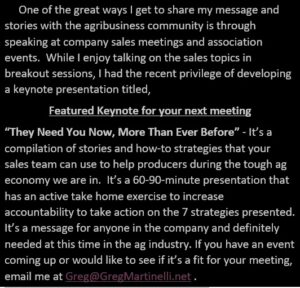Gray Areas in Ag Sales
“And I want full credit. I don’t care about your policy on returning treated seed. As a matter of fact, you should pay me for the time it took me to drive here. Gas isn’t free you know. I called you and told you to send me my seed. I get the planter all set up, it’s perfect weather to plant and I find out that you sent me the wrong seed. Now I’m delayed. It’s going to rain. I probably won’t get 1000 acres planted because you sent me the wrong stuff. You’re going to need to compensate me for yield loss on planting late”
“Carl, hold on a second. Let me…”
“I’m not holding on to anything. What I’m holding onto is the wrong bags of seed. You people need to get your act figured out and send customers what they order.”
“Carl”
“What?”
“Carl, that is the same seed you bought last year. We shipped you two different varieties last year. This is one of those varieties.”
“What are you talking about. I only ordered one variety last year but you guys swapped it for this garbage. I told you then that I didn’t want this variety anymore”
“Carl, let me get your salesman out to see you and get it figured out”
“Well, I’d appreciate it because I haven’t seen him in forever. Where’s he been hiding anyway?”
This scenario or some form of it plays out all across the Ag sector. Grain & livestock production and the Ag industry has a high volume of manual transactions. As much as we try to automate it, it still requires a lot of hands-on interpretation and head knowledge needed to run an Ag retail location or a feed office or the parts department at your local implement dealer.
Boom & Bust: Ag is highly seasonal. This means we have times of boom and bust. Often, we can’t staff to manage the boom and then keep that big staff during the downtime. So, during planting and harvest:
- The parts department is hustling hard to keep equipment running.
- Orders are coming in and going out faster than one person can answer the phone.
- Other people in the office are helping out to take orders.
- Orders are written on little sticky notes and not entered into the system – Because only Jolene enters seed orders. And nobody messes with the way Jolene enters orders.
- Customers are also under tremendous stress. They are busy farming. Too busy to realize until Friday afternoon at 4:30 that they are out of feed.
The result of all this chaos is a mistake. The cause or who is at fault and who should financially pay for that mistake is what I’m calling “The Gray Area”.
Who’s at fault and who pays for it? In this scenario:
- You have a policy of not returning treated seed.
- The customer wasn’t as clear on his instructions as he should have been.
- Telling someone to just send you his seed is not a clear order.
- When the order entry person at the retailer saw that the customer received two different seed types last year, he should have stopped the order until he found out the correct one to send.
- The seed was shipped a couple weeks ago. Carl should have brought it back sooner than the day he is supposed to plant.
In these situations, the list of shoulda woulda, coulda can go on forever. We can debate all those another day because right now, we need to jump in and keep the business moving. Carl is planting and needs seed.
Let’s skip ahead to how we handle this situation as the salesperson. At this point, you are completely unaware of all that is going on. You are out calling on a different producer, with your phone on silent. You jump in your truck to head to the next customer and you see that you have three missed phone calls. One from Carl, one from your office and one from your sales manager. While you’re listening to the ten minutes of voicemail dissertation as to who is at fault, you see that your seed company rep is calling you.
Sorting through all of it, we can sum it up this way
- Carl is mad and wants you to compensate him for everything. His list of “everything” keeps growing by the minute. He even thought up more as he was leaving the voicemail.
- The office has two problems. First, they need to know what to do to resolve the issue right now as Carl needs seed. Second, they feel bad this happened but also feel that Carl contributed to the problem. Lastly, Carl was a little belligerent on the call and maybe needs to be told not to call people names in the future.
- Your sales manager wants to know what you plan to do about the whole thing and questions who and how much should be compensated.
- Your seed company rep is calling because she just got the order for the correct variety. She doesn’t have it on hand but could scramble to find some if absolutely
 necessary. She reminds you that they absolutely don’t return treated seed.
necessary. She reminds you that they absolutely don’t return treated seed.
Here are some things to consider when faced with one of these gray areas:
- Past History
Is this the first time Carl had an issue or is it one of many? To me, it makes a big difference. If we have compensated Carl in the past for several of these gray area situations, then I’m less likely to pay for it. Maybe this is the fourth time he’s had the variety issue. On the other hand, if it has never happened and it seems like an honest mistake, then paying out makes sense.
Our past history as well. If we just hired a new person in the office and they are making multiple mistakes like this one, then I’m more likely to pay on it.
2. Size of the account:
I know this may not sound fair, but the reality is that the bigger the account, the more leeway you will give them. If this is 10 bags out of 1000, you are going to fix it. As a salesman, it’s going to come into your mind immediately. Who is the customer and how important are they in my territory? You will reason that, “I don’t want to win this one battle and lose the whole war. So, I’m going to compensate.”
3. Setting a precedence:
By paying out on this, am I opening up a can of worms as to future expectations? Am I setting the precedence that we will just pay out anytime there’s a problem? How have I handled it with other similar situations or similar customers? Is word spreading that this is an easy way to get free product or get a price discount? Try to think through the impact if every one of your customers found out how you handled this situation. Because, trust me, they will. The coffee shop crowd will talk.
4. Actual total cost of this one incident and how far you can go with compensation:
You need to know what the financial impact of compensating for this incident. When you give away free product, you don’t just give away the margin. You give away the entire cost of that product. For example, let’s assume, you sell that bag of seed for $300. You make a $30/bag margin on it. If you give that bag away, you lost $300, not $30. So, you are going to have to sell 10 bags to make up for that one bag you gave away. Not to mention the cost to administer it, deliver it and carry the accounts receivable on it.
Once you get past compensation for the actual product, customers will start reaching into that even bigger gray area around “yield loss” or “lost time” or “their lost sales to their customer”. This is a really wide open gray area that you either need to shut down quickly or get some help from your sales manager and legal adviser. There’s an old saying that “Your first loss will be the least loss”. It implies that if you don’t resolve something quickly like this, the customer gets angrier and starts to ask for more and more compensation. By the next morning, he’s asking to be compensated for mental anguish and throwing out his back when returning the bags.
5. Liability: I’m not a lawyer and this is not legal advice. But, you need to think like one at times. Realize that there are legal ramifications of compensating a customer. It can be viewed as admitting some form of guilt. In addition, you may give an initial compensation like free bags and then the customer comes back for more. A release form will usually have wording in it that this is the final compensation for this issue and the customer agrees they can’t come back for more. Most of the issues you deal with won’t be so serious that you need a signed release. However, you need to know when you’re in over your head and need help.
Ag is fast paced and has a lot of opportunities for things to go wrong. Combine that fast pace with multiple human transactions and you have a recipe for a lot of gray areas. These gray areas are the reason you are there.
It’s your judgment that will:
- Keep the customer,
- Not give away all your profits and hopefully,
- Come out on the other end of this situation with a stronger customer relationship.
Good luck!



